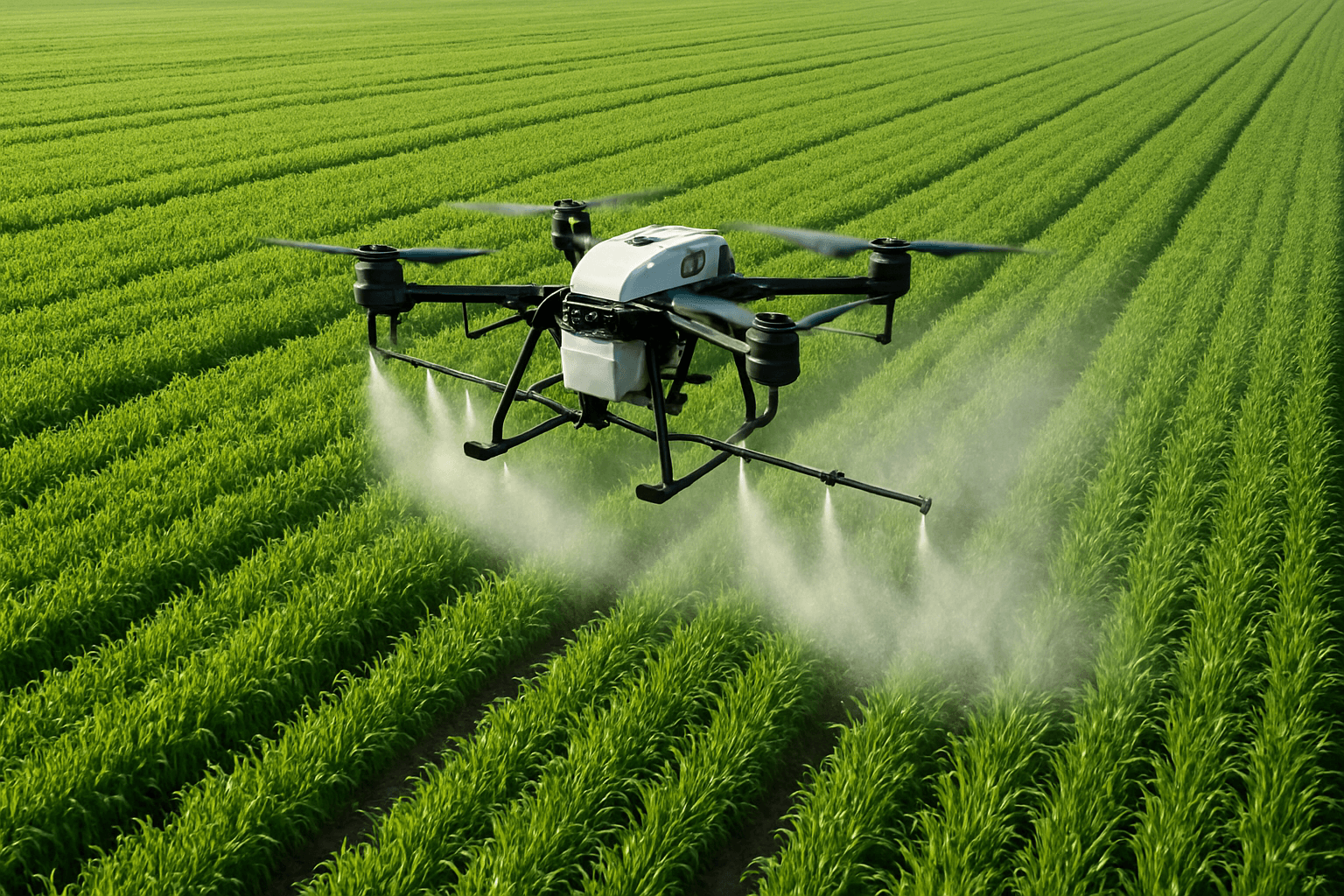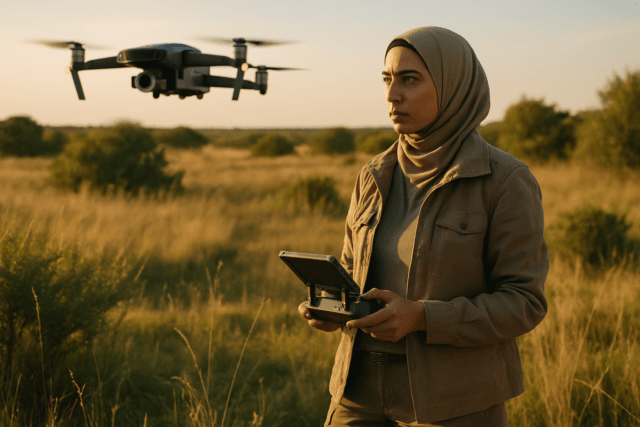Drone fertilizer application is revolutionizing the agriculture industry, offering a more efficient, precise, and sustainable approach to crop management. By using drones, farmers can optimize fertilizer use, reduce waste, and improve crop yields, all while minimizing environmental impact.
Why Use Drones for Fertilizer Application?
Here’s a breakdown of the key advantages:
- Precision Application: Drones can apply fertilizer precisely where it’s needed, based on real-time data and advanced mapping systems. This targeted approach avoids waste and ensures that each plant receives the optimal amount of nutrients.
- Increased Efficiency: Drones can cover large areas quickly and efficiently, significantly reducing the time and labor required for fertilizer application. Depending on the drone’s capacity, it can spray fertilizer on 50 to 100 hectares per day, which is 30 times more than a traditional knapsack sprayer.
- Cost Savings: By optimizing fertilizer use and reducing labor costs, drones can lead to substantial cost savings for farmers. The cost of spraying with drones can be 97% lower compared to conventional spraying methods.
- Reduced Environmental Impact: Precision application minimizes over-spraying and chemical runoff, reducing the risk of water and soil pollution. Drones can also help reduce soil compaction and erosion, as nutrients are distributed by air.
- Improved Crop Health: Drones enable real-time monitoring of crop health, allowing for early detection of nutrient deficiencies and timely intervention. This can lead to healthier plants, increased yields, and improved crop quality.
- Accessibility: Drones can access difficult or remote terrain, making it easier to apply fertilizer to areas that are hard to reach with traditional methods. They can also operate in wet conditions where heavy machinery might get stuck or cause damage.
- Data Collection and Analysis: Drones equipped with sensors and cameras can collect valuable data on crop health, soil conditions, and environmental factors. This data can be used to create detailed maps and inform decision-making regarding fertilizer application and other crop management practices.
Drone Tech: How it Works
Fertilizer spraying drones are designed to distribute fertilizers across farm fields accurately and evenly. Equipped with GPS navigation and automated spraying systems, these drones ensure uniform coverage and improve crop health.
Smart technology, including sensors and AI, simplifies precision farming. By adjusting spraying patterns based on real-time data, drones improve fertilizer use and minimize waste.
Here’s a closer look at the tech involved:
- LIDAR Technology: Some drones use LIDAR (Light Detection and Ranging) technology to create high-resolution maps of the terrain. This allows for precise application of fertilizer, even in areas with uneven topography.
- Multispectral Imaging: Drones with multispectral cameras capture images beyond visible light, monitoring crop health and creating drought maps. This information helps farmers optimize nutrient distribution and detect early signs of pests and diseases.
- AI-Powered Spraying: Some drones use AI to analyze data and adjust spraying schedules accordingly. This ensures that fertilizers are applied only where needed, minimizing excess use and environmental impact.
- Variable Rate Application: Drones can vary the application rate of fertilizer based on the specific needs of different areas within a field. This is particularly useful for addressing variations in soil fertility and crop health.
UK Regulations for Drone Fertilizer Application
In the UK, the use of drones for agricultural purposes is regulated by the Civil Aviation Authority (CAA). While the application of pesticides by drone is currently restricted due to a lack of data on human and environmental exposure, the use of drones for fertilizer application is permitted under certain conditions.
Here are some key points to consider:
- Operational Authorization: Farmers or drone operators need to obtain operational authorization from the CAA for commercial drone activities.
- Training and Certification: Operators must undergo appropriate training and certification to ensure they can operate drones safely and effectively. Harper Adams University offers training courses for drone operators.
- Weight Restrictions: Drones with a take-off weight of more than 25kg are subject to stricter regulations.
- Product Restrictions: Current UK legislation prohibits the aerial application of any product that comes with a “map number,” which includes most herbicides, fungicides, and insecticides. However, fertilizers, biostimulants, and organic products can be applied by drone.
- Safety and Environmental Considerations: Operators must ensure that drone operations do not pose a risk to human health or the environment. This includes minimizing spray drift and avoiding sensitive areas.
Choosing the Right Drone
Selecting the right drone for fertilizer application depends on various factors, including farm size, terrain, and budget. Here are some key considerations:
- Farm Size and Terrain: For large farms, fixed-wing drones may be more suitable due to their ability to cover large areas quickly. Multi-rotor drones are a popular choice for small to medium-sized farms due to their precision and maneuverability.
- Spray Capacity and Battery Life: Longer battery life and larger payload capacity allow for more coverage with fewer refills.
- Advanced Technologies: Look for drones with smart features like GPS navigation, AI-powered spraying adjustments, and obstacle avoidance systems.
- Cost: Consider the upfront costs of the drone, as well as long-term savings in labor and fertilizer.
Some popular drone models for fertilizer application include:
- DJI Agras Series (T40, T30, T20): Known for their powerful spraying capabilities, intelligent terrain-following systems, and AI-powered features. The Agras T40 boasts a 40-liter spray tank and a 12-meter spray width.
- XAG P100 Pro: Features AI-driven route planning and dual-atomization nozzles for ultra-fine spraying.
- Yamaha RMAX: A heavy-duty spraying drone with a high payload capacity, suitable for large farms.
Potential Challenges
While drone fertilizer application offers numerous benefits, there are also some challenges to consider:
- Evolving Regulations: Regulations regarding drone use in agriculture are constantly evolving, and it’s important to stay informed about the latest rules and requirements.
- High Initial Costs: The initial investment in drone technology can be significant, which may be a barrier for some farmers. However, costs are decreasing as the technology becomes more widespread.
- Technical Expertise: Operating drones requires technical expertise and training. Farmers may need to invest in training or hire qualified drone operators.
- Weather Limitations: Drones are susceptible to mechanical failures and adverse weather conditions, which can interrupt farming operations.
- Data Security and Privacy: The collection and storage of data by drones raise concerns about data security and privacy.
Drone Application: Case Studies
- Yield Increase in Corn Fields: Lidar drones have been used to precisely apply nutrients and detect early signs of pests and diseases in corn fields, leading to significant yield increases.
- Reduction of Fertilizer Waste: High-resolution maps and site-specific nutrient data from drones ensure that fertilizers are applied only where necessary, minimizing excess use and environmental impact.
- Rice Production: In Japan, variable-rate fertilization using DJI drones resulted in a 20% reduction in fertilizer use and an 8% increase in rice yield.
- Pineapple Plantation: A case study in Malaysia found that using drones for fertilizing and herbicide spraying in a pineapple plantation reduced manpower costs by 41.6% and water consumption by 34%.
The Future of Fertilizer Application
Drone fertilizer application is transforming agriculture, offering a more efficient, precise, and sustainable way to manage crops. As technology advances and regulations evolve, drones are poised to play an even greater role in the future of farming. By embracing this technology, farmers can improve their productivity, reduce their environmental impact, and contribute to a more sustainable food system.





